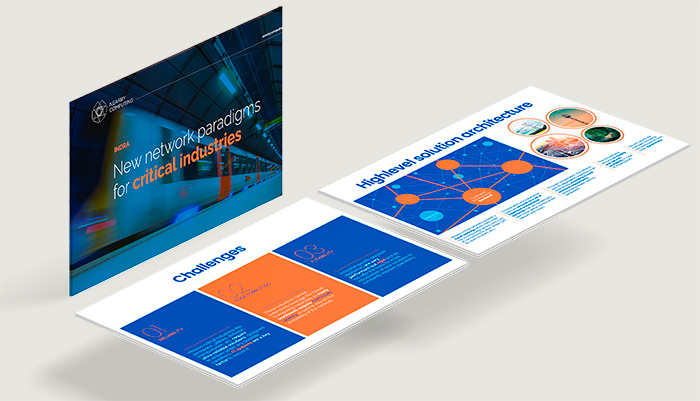INDRA
New network paradigms for critical industries
Challenges
01
RELIABILITY
Mission-critical industries like aerospace, utilities, defense, transportation, etc. require ultra-reliable solutions, designed to deliver under any possible conditions. IT systems are a key factor to secure it.
02
EDGE COMPUTING
These industries cannot extensively leverage the Cloud Computing capacities as many workloads require controlled latency or cannot rely on the availability of the network.
03
FLEXIBILITY
Industrial specific-purpose appliances are very performant but rigid and do not offer the basis for a fast introduction of new solutions to constantly improve operations.
Highlevel solution architecture

Mission-critical networks present a cloud topology where each node has a computing capacity and a list of connections to other nodes (SAT, 5G, point-to-point, etc.)
Through orchestration, the network uses its aggregated capacities in an optimal way according to each workload requirements (processing power, latency, bandwidth).
Security levels are managed following the workloads of each node, dynamically.
Orchestration and automation tasks are ensured by a set of federated orchestration backends that can dynamically take full or partial control of the network and nodes.
The Orchestrator ensures re-routing and network availability in case of missing links.
Mission-critical Use Cases
Automated substation control through AGV and video analytics via Mobile Private 5G.
Edge-to-Cloud IoT analytics.
Mission-Critical Comms.
Smart meters management.
5G MEC deployment in remote sites: video analytics, CDN, IoT
Dynamic sizing of resources according to traffic status.
Neutral host architecture.
Dynamic routing, multi-network management.
Tactical objectives injection as an orchestration policy.
Enhanced security.
Automated service recovery.
Federated orchestration.
Tactical 5G.
Outcomes
1. Ultra-performant network, meeting the strongest SLA requirements
2. Continuous network observation
3. Fast reconfiguration capability
4. Managed Security
NearbyOne
- Dynamic orchestration to enable the achievement of defined goals amidst an ultra-changing, managed and unmanaged environment.
- Continuous monitoring and analysis of the network status to re-configure it on-the-fly (core, routing, security, etc.) when needed.
- Multi-network (5G, SAT, etc) coordination.
- Distribution of virtualized apps and related network configuration to guarantee service performance and continuity. Integration of AI workloads.
- Intra-node orchestration to cater for the specific hardware needs of every application and ensure performance in a shared computing environment.

INDRA
New network paradigms for critical industries




